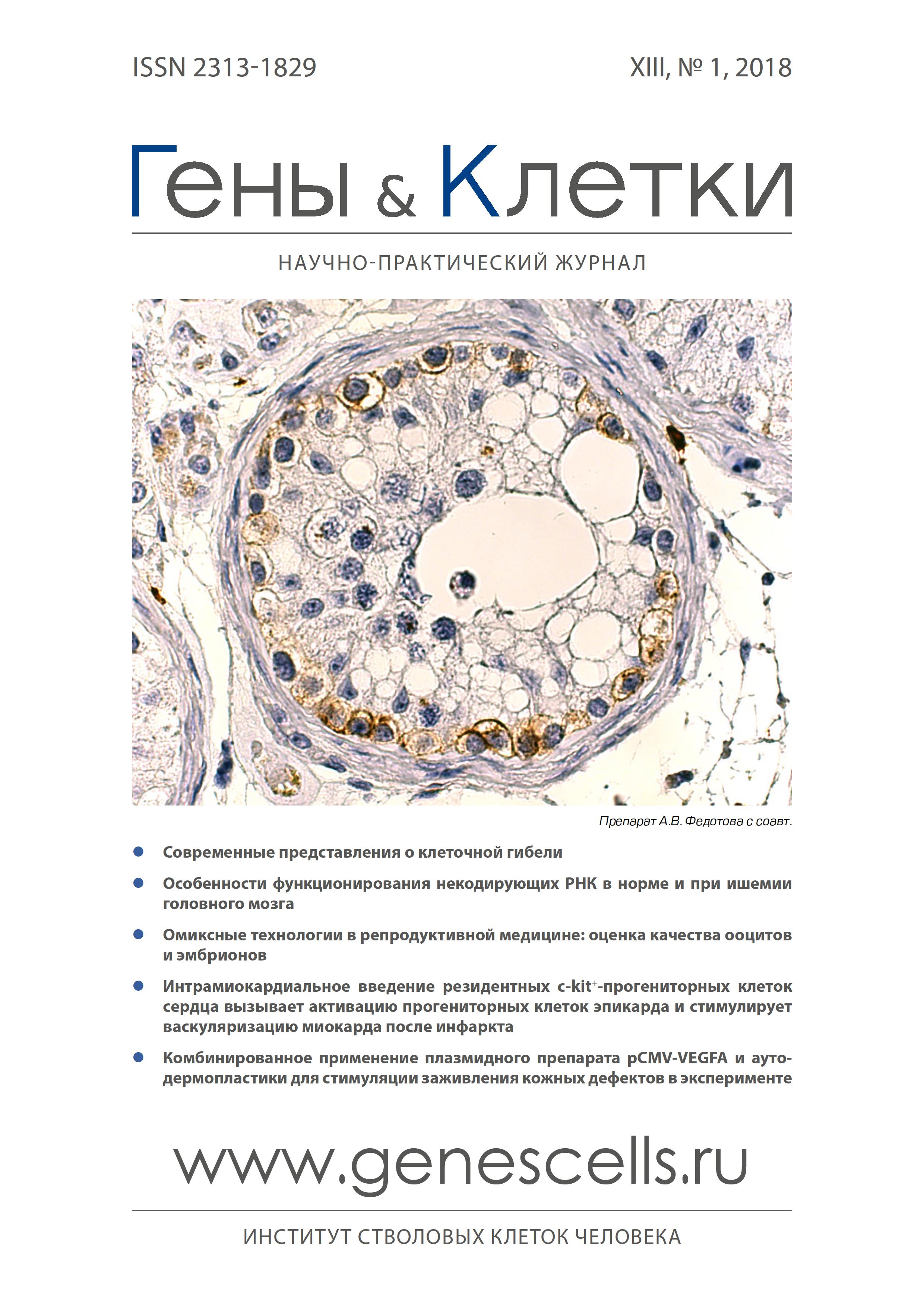Interleukin-8 is able to promote pro-inflammatory activity of human monocytes (macrophages)
- Authors: Meniailo M.E1,2, Malashchenko V.V1, Shmarov V.A1, Gazatova N.D1, Melashchenko O.B1, Goncharov A.G1, Seledtsova G.V3, Seledtsov V.I2
-
Affiliations:
- Immanuel Kant Baltic Federal University
- Russian Research Center of Medical Rehabilitation and Balneotherapy
- Scientific Research Institute of Clinical Immunology
- Issue: Vol 13, No 1 (2018)
- Pages: 65-69
- Section: Articles
- Submitted: 05.01.2023
- Published: 15.03.2018
- URL: https://genescells.ru/2313-1829/article/view/120726
- DOI: https://doi.org/10.23868/201805007
- ID: 120726
Cite item
Abstract
Keywords
Full Text
About the authors
M. E Meniailo
Immanuel Kant Baltic Federal University; Russian Research Center of Medical Rehabilitation and Balneotherapy
Email: max89me@yandex.ru
VV. V Malashchenko
Immanuel Kant Baltic Federal University
VA. A Shmarov
Immanuel Kant Baltic Federal University
N. D Gazatova
Immanuel Kant Baltic Federal University
O. B Melashchenko
Immanuel Kant Baltic Federal University
A. G Goncharov
Immanuel Kant Baltic Federal University
G. V Seledtsova
Scientific Research Institute of Clinical Immunology
V. I Seledtsov
Russian Research Center of Medical Rehabilitation and Balneotherapy
References
- Brat D.J., Bellail A.C., Van Meir E.G. The role of interleukin-8 and its receptors in gliomagenesis and tumoral angiogenesis. Neurooncol. 2005; 7(2): 122-33.
- Меняйло М.Е., Малащенко В.В., Шмаров В.А. и соавт. Прямое влияние интерлейкина-8 на активацию Т-клеток. Российский иммунологический журнал 2016; 10(2): 174-8.
- Bickel M. The role of interleukin-8 in inflammation and mechanisms of regulation. J. periodontol. 1993; 64(5): 456-60.
- Hedges J.C., Singer C.A., Gerthoffer W.T. Mitogen-activated protein kinases regulate cytokine gene expression in human airway myocytes. Am. J. Respir. Cell. Mol. Biol. 2000; 23(1): 86-94.
- Casilli F., Bianchini A., Gloaguen I. et al. Inhibition of interleukin-8 (CXCL8/IL-8) responses by repertaxin, a new inhibitor of the chemokine receptors CXCR1 and CxCR2. Biochem. Pharmacol. 2005; 69(3): 385-94.
- Segerer S., Henger A., Schmid H. et al. Expression of the chemokine receptor CXCR1 in human glomerular diseases. Kidney int. 2006; 69(10): 1765-73.
- Nasser M.W., Raghuwanshi S.K., Grant D.J. et al. Differential activation and regulation of CXCR1 and CXCR2 by CXCL8 monomer and dimer. J. Immunol. 2009; 183(5): 3425-32.
- de Oliveira S., Rosowski, E.E., Huttenlocher A. Neutrophil migration in infection and wound repair: going forward in reverse. Nat. Rev. Immunol. 2016; 16(6): 378-91.
- Jacobs J.P., Ortiz-Lopez A., Campbell J.J. et al. Deficiency of CXCR2, but not other chemokine receptors, attenuates autoantibody-mediated arthritis in a murine model. Arthritis Rheum. 2010; 62(7): 1921-32.
- Ziegler-Heitbrock L., Ancuta P., Crowe S. et al. Nomenclature of monocytes and dendritic cells in blood. Blood 2010; 116(16): e74-e80.
- Italiani P., Boraschi D. From monocytes to M1/M2 macrophages: phenotypical vs. functional differentiation. Front. immunol. 2014; 5: 514.
- Allaire M.A., Tanne B., Côte S.C. et al. Prostaglandin E2 does not modulate CCR7 expression and functionality after differentiation of blood monocytes into macrophages. Int. J. Inflam. 2013; 2013: 918016.
- Yang J., Zhang L., Yu C. et al. Monocyte and macrophage differentiation: circulation inflammatory monocyte as biomarker for inflammatory diseases. Biomark. Res. 2014; 2(1): 1.
- Kitchens R. Role of CD14 in cellular recognition of bacterial lipopolysaccharides. Chem. Immunol. 2000; 74: 61-82.
- Martinez F.O., Gordon S. The M1 and M2 paradigm of macrophage activation: time for reassessment. F1000 Prime Rep. 2014; 6(13.10): 12703.
- Tau G., Rothman P. Biologic functions of the IFN-y receptors. Allergy 1999; 54(12): 1233-51.
- Nelms K., Keegan A.D., Zamorano J. et al. The IL-4 receptor: signaling mechanisms and biologic functions. Annu. Rev. Immunol. 1999; 17(1): 701-38.
- Junt T., Scandella E., Foster R. et al. Impact of CCR7 on priming and distribution of antiviral effector and memory CTL. J. Immunol. 2004; 173(11): 6684-93.
- Duque G.A., Descoteaux A. Macrophage cytokines: involvement in immunity and infectious diseases. Front. Immunol. 2014; 5: 491
- Rey-Giraud F., Hafner M., Ries C.H. In vitro generation of monocyte-derived macrophages under serum-free conditions improves their tumor promoting functions. PloS one 2012; 7(8): e42656.
- Seledtsov V.I., Seledtsova G.V. A balance between tissue-destructive and tissue-protective immunities: a role of toll-like receptors in regulation of adaptive immunity. Immunobiology 2012; 217(4): 430-5.
- Muraille E., Leo O., Moser M. TH1/TH2 paradigm extended: macrophage polarization as an unappreciated pathogen-driven escape mechanism? Front. Immunol. 2014; 5, 603.
- Zhang Z., Song L., Maurer K. et al. Monocyte polarization: the relationship of genome-wide changes in H4 acetylation with polarization. Genes Immun. 2011; 12(6): 445-56.
- Gesser B., Deleuran B., Lund M. et al. Interleukin-8 induces its own production in CD4+ T lymphocytes: a process regulated by interleukin 10. Biochem. Biophys. Res. Commun. 1995; 210(3): 660-9.
- Brown K.D., Claudio E. The roles of the classical and alternative nuclear factor-kappa B pathways: potential implications for autoimmunity and rheumatoid arthritis. Arthritis Res. Ther. 2008; 10(4): 212.
Supplementary files










